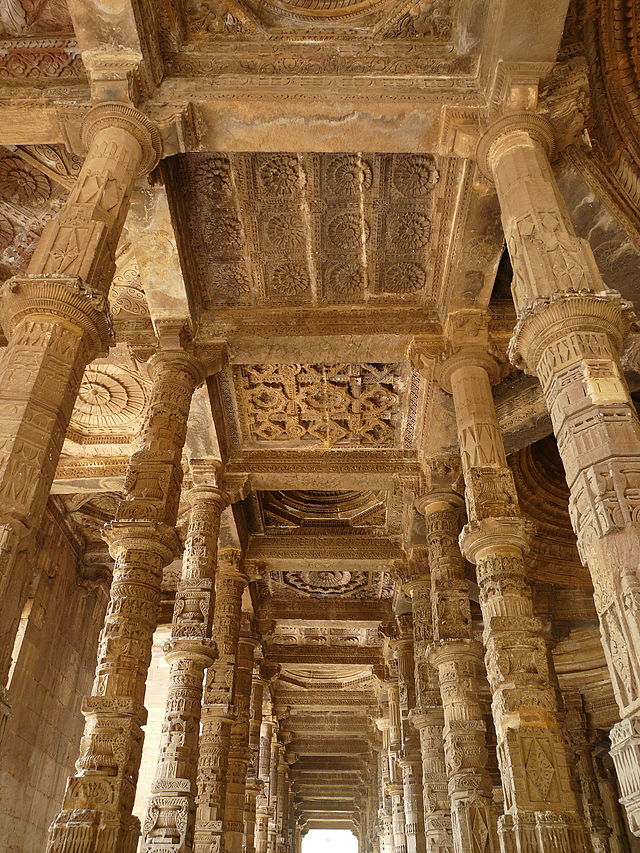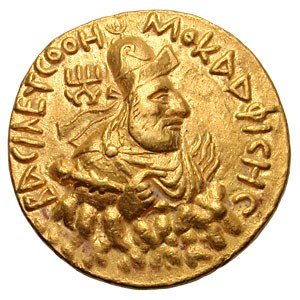Coins of Satavahanas
Satavahanas, also known as Andhra, is one of the most celebrated dynasty of ancient India. Satavahanas ruled over large area of western and southern India (modern Maharashtra, Gujarat, Andhra Pradesh, Karnataka and Goa states). The kings of this dynasty were great patrons of art and architecture. They built many beautiful stupas in Krishna River Valley. The impressive stupa of Amrawati, Jaggiahpeta and Nagarjunkonda were built by them. The railing were carved out of white marble and dome was also covered with marble slabs creating a breathtaking example of ancient stupa building art. The railing were exquisitely carved with various scenes from the life of Buddha. The figures themselves are slim with elegant features and display striking difference in style from the northern India.
The Amarawati Stupa represent a new school of art, which is named after it. Unfortunately this stupa is in ruins today and the railings have been taken away for display in the British Museum, London and Government Museum, Madras. Shown on right is a casing slab from the Amarawati stupa on which the miniature of the stupa is carved. This marvelous sculpture might allow us to imagine the grandeur of this great stupa.

This dynasty came into existance soon after disintegration of Mauryan empire (i.e. after death of Great Ashoka). Satavahana dynasty was founded by Simuka (or Chimuka) in 232 BC but it was his son (or nephew?) Satakarni I who made Satavahanas as most formidable power of western and southern India. With the help of powerful Maharathi chieftains (ancestors of Marathas), he brought a large part of southern and western India under his control and later celebrated this victory with Ashwamedha yagna (horse sacrifice ceremony).
After death of Satkarni I, India was invaded by many foreign powers like Shakas (Scythias), Yavanas (Greeks) and Pahalavas (Parthians). At this stage, Gautamiputra Satakarni (86-110 AD) took control of dynasty and crushed the foreign invaders. It was Gautamiputra who scored a decisive victory over Kshatrapa (Shaka or Scythian) ruler of central India, and thus built the empire of Satavahanas, covering Malva (central India), western and southern India. Gautamiputra Satakarni took pride calling himself `Destroyer of Shaka, Yavana and Pahalava’ and restruck on the Shaka ruler Nahapana’s silver coins with his name and royal emblem for circulation in his empire. Centers of art and commerce like Amrawati (in Andhra Pradesh) and Vaijayanti (Karnataka) flourished during his reign. Very likely he did not issue his own silver currency.
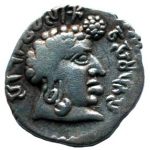
Vashistiputra Shree Pulumavi
Satavahana Dynasty 78-114 AD or 110-138 AD
Silver Drachm or Dramma,
Weight: 2 gms
Obverse: Kings bust looking right, depicting nice and elaborate hair style, large ear rings and legend, Rano Vasithiputasa Siri Pulumavisa
Reverse: Satavahan royal emblem, hill or six hilled Cahitya, sun, moon, water and complete legend, Arahanaku Vahitti makanaku Tiru Pulumaviku
Reference: Mitchiner South India, 1998: 146
Very Rare, The first portrait type of silver coin of India
This dynasty also have unique distinction of issuing the coin with the portrait of ruler. No indigenous dynasty issued portrait type silver coins till one of the Satvahana ruler, Vashishtiputra Shri Pulumavi issued the portrait type coins (shown above). On obverse King is shown with an elaborate hair style and large ear rings. Almost complete Legend in Brahmi script (Sanskrit-derived Prakrit language) that starts at XII position Rano Vasithiputasa Siri Pulumavisa. The Reverse has the Satavahan royal emblem, which is a six hilled Chaitya, sun, moon, water and complete legends in Southern Brahmi script (early Telugu-Prakrit language), start at XII, Arahanaku Vahitti makanaku Tiru Pulumaviku.
Numismatic studies played a crucial role in deciphering history of Satavahana dynasty. Some of the rulers who otherwise find no mention in Puranas (the contemporary texts, which provide Satavahana chronology), are known only from their coinage. Satavahana silver portrait coins possess high degree of artistic beauty. Although, essentially minted in Kshatrapa fabric, they are unique in style. Some of the physical traits depicted on these coins (e.g. curly hairs, long ears, their lips etc) suggests their Dravidian origin, and thus might be their real portraits, rather than the stylized version. The reverse side often shows `Ujjain symbol’, a cross with four circles at the end. Shown below are two outstanding examples of the Satavahana portrait coins.

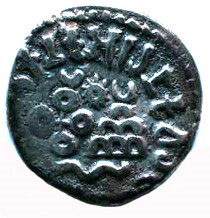
Vashistiputra Shree Satakarni
118-147 AD Silver Drachm or Dramma,
Weight: 2 gms, Silver
Obverse: Kings bust looking right, depicting nice and elaborate hair style, large ear rings. Legend in Brahmi script (Sanskrit Prakrit language), at XII position:Rano Vasithiputasa Siri Pulumavisa
Reverse: Satavahan royal emblem, hill or six hilled Cahitya, sun, moon, water and complete legends in Southern Brahmi script (Telugu Prakrit language), start a t XII : Arahanaku Vahitti makanaku Tiru Hatakaniku
Reference: Mitchiner South India, 1998: 147-149; Numismatic Digest Vol III, Part II, Dec 1979, pp 31-34
Very Rare

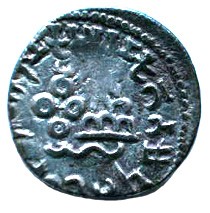
Gautamiputra Shree Yagna Satakarni
167-196 AD
Silver Drachm or Dramma, Weight: 2 gms, Silver
Obverse: Kings bust looking right, depicting nice and elaborate hair style with a pony tail, large ear rings. Almost complete Legend in Brahmi script (Sanskrit Prakrit language), starts at XII position: Rano Gotamiputasa Siri Yana Satakanisa
Reverse: Satavahan royal emblem, hill or six hilled Cahitya, sun, moon, water and legends in Southern Brahmi script (Telugu Prakrit language), starts at XII position: Arahanaku Gotami Putaku Hiru Yana Hatakaniku
Reference: Mitchiner South India, 156-157; Numismatic Digest Vol III, Part II, Dec 1979, pp 31-34
Very Rare
Vashishtiputra Pulumavi who had his capital at Pratishsthan (modern Paithan in Maharashtra state) on the banks of Godavari river, issued the portrait type coins. Thus, he has distinction of being THE FIRST RULER who issued PORTRAIT TYPE SILVER COINS in India. His silver coins are rare, shown on top.
Pulumavi was followed by his brother Vashishtiputra Satakarni, who married daughter of Rudradaman I of Kshatrapa dynasty (described below). Although, this alliance did not stop Rudradaman to score a fantastic victory over Vashishtiputra, which gave tremendous blow to Satavahana power and prestige. Shri Yajna Satakarni followed and tried to revive power of Satavahans, but he turned out to be the last great king of this illustrious dynasty. Soon after his death, Satavahana empire collapsed and 456 years of Satavahana rule (totally 30 kings ruled) came to an end.
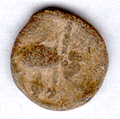
Satakarni IV
154-164 AD
Potin unit (Half Karshapana ?)
Obverse: Elephant
Reverse: Ujjain symbol
Weight: 1.8 gm
Many dynasties emerged on the ruins of Satavahana empire. Vakatakas rose to power in Vidarbha region (eastern Maharashtra), Abhiras (king Ishwarsena) occupied Nashik and nearby region of western Maharashtra. Chutukulananda (another line of Satkarnis) occupied most of the western Karnataka with a capital at Vaijayantipura (Banwasi). The main imperial line of Satavahanas ruled in small fertile valley of Krishna river, which eventually succeeded by Vishnukundins.
Coins of Kshatrapas
The western and central part of India consisting of Saurashtra and Malwa (modern Gujrat and neighbouring Maharashtra, Rajasthan and Madhya Pradesh states) was ruled by rulers known as Ksatrapa or Kshatrapas. This prosperous region was goverend by 27 independent Kshatrapa rulers for about 350 years. The term Kshatrapa is considered to be Sanskritized version of old Persian word `Ksatrapavan’, the protector of land or viceroy. The Shaka-Pahalava kings of present day Iran and Afghanistan ruled over a large area and governors of the provinces of these empire were known as `Satraps or Ksatrapas’. It is believed that the early Kshatrapa rulers which belonged to Kshaharata family, occupied north-western and central India adjoining Mathura and possibly ruled as viceroys of Kushans (this is a controversial issue, it is likely they were never true vassals of Kushan). Nevertheless, very soon they acquired enough territory to be sovereign rulers. Although, they retained name Kshatrapa, they were indeed independent rulers as some of the later rulers even proclaimed themselves Mahakshtrapas, the great Kshatrapas. Since the later Kshatrapas ruled mainly in Saurashtra and Malwa region (western India), they are called Western Kshatrapas to distinguish them from early rulers (Kshatrpas) who ruled Mathura and adjoining region (and lost that territory to expanding Gupta empire).
The early Kshatrapas became independent rulers by carving out a principality on the ruins of Satavahana empire. These kings have minted some of the most fascinating silver coins of Indian numismatic history. The life-like portraits of the rulers of early rulers suggests that different dies were made as king grew older, clearly indicating the high degree of care taken while minting their coinage. These remarkable series of silver coins became extremely popular not only in the western provinces directly governed by Kshatrapa rulers, but also in the adjoining regions, possibly whole of northern, central and western India. The rulers of neighboring empires/kingdoms like Satavahanas, Guptas and many successive dynasties those followed Kshatrapas, minted their coinage in Kshatrapa style, providing proof of the immense popularity of Kshatrapa coinage. Apart from aesthetic nature, this series has turn out to be very crucial in deciphering the early history of India. These coins with complete name of ruler, his father’s name and date of issue, provided historians necessary evidence for determination of genealogy of not only the Kshatrapa rulers, but also immensely helped in deciphering the duration of reigns of their contemporary rulers in adjoining kingdoms/empires.

Nahapana as Kshatrapa
119-124 AD or 41-46 Saka Years
Silver Dramma
Obverse: Bust of King wearing cap
Reverse: Arrow and thunderbolt, Legends in Kharoshti and Brahmi, Weight: 2.2 gm
Reference: MAC#2682-2684
CNG specimen, Auction 384, Lot 398
This dynasty attained great power under king Nahapana, who conquered a large part of western and central India, which was part of Satavahana empire. This brought him in direct conflict with the greatest Satavahana emperor, Gautamiputra Satakarni. Gautamiputra squarely defeated Nahapana and reoccupied the lost territories in 124 AD. In spite of his defeat, Nahapana strengthened his hold over remaining territories and his successors in time became paramount rulers of western India. Nahapana was founder of the Kshatrapa monetary system and was the first Kshatrapa who minted portrait type silver coins. His coins show his diademed bust with Greek legends on obverse, which is the reminiscent of Indo-Greek coinage. The reverse show arrow and thunderbolt with legends in Prakrit (in heavily Sanskritized form) written in Kharoshti and Bramhi scripts. The legends in Kharoshti reads, Rano Chaharatasa Nahapanasa, while legends in Brahmi reads Rajana Kshaharatasa Nahapanasa. Shown above is a nice example of his coinage.
Chastana followed Nahapana and established himself at Ujjain and ruled large part of western India. His grandson Rudradaman (130-150 AD) was perhaps the greatest Shaka ruler of ancient India. Rudradaman entered into matrimonial alliance with the great Satavahanas of Deccan and later even defeated them, extending his kingdom from Marwad to Konkan (from Rajasthan to Maharashtra). His achievements are carved at Junagadh rock inscription.
Rudrasen II (256-278 AD) was 19th ruler of Kshatrapa family and minted prodigious number of coins, exclusively as Mahakshatrapa. This indicate the prosperous period of Kshatrapa dynasty. Unlike the early Ksatrapa rulers, the later rulers had no Greek legends on obverse and reverse had legends written almost exclusively in Brahmi. Kharoshti script was primarily used in north-western parts of India and since later Kshatrapas dominion was confined to western India where Brahmi script was used, Kharoshti was withdrawn from the coins. Similarly, all the coins of later Kshatrapas bear the chaitya or three arched hill and river symbol on reverse of their coins, instead of thunderbot and arrow. This coin of Rudrasen bears Bramhi inscription which reads, Rajanah Ksatrapasa Viradamaputrasa Rajno Mahakstrapasa Rudrasensa, on reverse, which can be translated as King Kshatrapa Viradaman’s son King Mahakshatrapa Rudrasena.
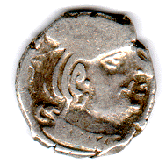
Rudrasen II as Mahakshatrapa
256-278 AD
Silver Dramma
Obverse: Bust of King
Reverse: Hill and riverWeight: 2.2 gm
Reference: MAC#2722-2741
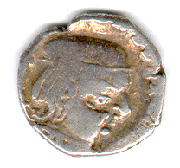
Vishwasen
294-304 AD
Silver Dramma
Obverse: Bust of King
Reverse: Hill and riverWeight: 2.3 gm
Reference: MAC#2780-2795
Bhratadaman was Rudrasen’s son who ruled from 278 to 295 AD and minted very similar coins as that of other Kshatrapa rulers. His brother Vishwasen was the last ruler of the Kshatrapa descent, who was replaced by Rudrasimha. Rudrasimha was not related to the royal family. This new family could not keep the control of this kingdom and soon the Gupta emperor Vikramaditya conquered and incorporated the Kshatrapa Kingdom in his mighty Gupta empire.
The Maitrakas of Valabhi
In Saurashtra (modern Gujrat), Bhattaraka established a new independent kingdom during decline of Gupta empire. This new kingdom of Valabhi was ruled by Maitraka family for next 350 years. All the coins issue by Valabhi rulers were in the name of Bhattaraka, who took a title of Senapati, the army general. The coins of this dynasty are minted in Kshatrapa style depicting bust of ruler (highly stylize in the later issues) on obverse, while reverse depict the trident (Shastra or weapon of Lord Shiva) with or without side arm. The legends are present on reverse written in Brahmi script, which reads Rajno Mahakshatrapa Paramaditya Bhakta Mahasamanta Sri Sarva Bhattarakasa.
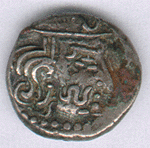
Bhattaraka (title: Senapati)
470-800 AD
Silver Dramma
Obverse: Bust of King
Reverse: Trident with curved prong
Weight: 1.9 gm
Reference: MAC#4894
COINS OF POST-GUPTA DYNASTIES
Skandagupta put up the brave struggle against barbaric Huns and even won decisive battles against them. But he turned out to be the last great Gupta emperor. Battling the barbaric tribes of Huns and internal uprising of Pushyamitras who were Gupta feudatories, made the Gupta empire weak. Budha Gupta was the last Gupta emperor. By sixth century AD Gupta empire was completely disintegrated and Huns, Toramana and his son Mihirgula had firmly established themselves in Sialkot region (modern Pakistan).
At this stage Yasodharman who belonged to a family which were feudatories of Gupta, emerged and bravely defended Gupta territory against tyrant Hun ruler, Mihirgula. Maukahri, another feudatory family also rose to distinction and bravely carried on the struggle against these foreign invaders. But the next dynasty of significance in post-Gupta India was Vardhanas of Thanesar, rulers of which brought disintegrated Gupta empire together and later even managed to revive those glorious days of Vikramaditya.
Post-Gupta era clearly show decline in artistry in coinage. Except few, most rulers hardly paid any attention towards their coinage. Unlike Gupta and Kushan emperors who used their coinage for propaganda and minted fine specimen of numismatic arts, post-Gupta successors rarely experimented with their coinage. Most of the time post-Gupta rulers copied motifs from earlier Gupta coinage, where the stylization of the image of Laxmi or Lakshmi is clear. These rulers hardly introduced any novel iconographic features or motifs. Often, the great ruler of dynasty issued a specific type of coin, which was minted by his successors without making any change, sometimes even the name! Thus often coinage of whole dynasty was struck in name of one (or two rulers) with identical motifs except the later coinage is debased compared to the earliest. Interestingly, many of these post-Gupta rulers had great tastes and they undertook construction of some of the most beautiful temples of India with fantastic architecture and breathtaking sculptures. But, why their coinage received almost no attention is still a mystery. Some major dynasties of Post-Gupta era which introduced interesting coinage are discussed below.
The Vardhanas of Kannauj and Thanesar

Harshavardhana (Siladitya)
606-647 AD Vardhana/Pushyabhuti Dynasty
Silver Drachm, 2.33 gms
Obverse: Bust of King
Reverse: Peacock
Current provenance: Unknown
Vardhana dynasty assumed substantial power and prestige during rule of Prabhakarvardhana, who was of later Gupta lineage. His son Harshavardhana brought up whole of central India under his command and made Kanyakubj (modern Kannauj) as his capital. Harshavardhana is perhpas the greatest king in post-Gupta history of India, who revived the glorious days of Gupta emperors. Harshavardhana took a title of Siladitya and later received embassies from China. The Chinese traveler and scholar Xuan Zang (Hieun Tsang) has left a detail record of his army as well as his charity work. He organized the greatest religious gathering of medieval time called Mahamokshaparishad at Prayag (Allahabad), which was attended by Hiuen Tsang and described that apart from 20 kings, thousands of Buddhist, Hindu and Jain priests and scholars attended this meeting. At the end of this meeting, Harsha started distributing his personal belongings which he kept doing till he was left with nothing!
Harsha, a grandson of Gupta princess, had an ambition to emulate his great ancestors, Samudragupta & Vikramaditya. His coinage are greatly influenced by later silver coinage of Gupta emperors, especially Skangagupta’s Peacock type silver Drachm (Shown above). He was a capable general and good administrator with sophisticated tastes. Some of the finest intellectuals of early period like Bana (who wrote Harsha Charita), Mayura, Divakara and Hiuen Tsang adorned his court. Harsha died in 646 AD and with his death the Vardhana empire collapsed and fragmented into various smaller kingdoms.
The Imperial Pratiharas
By ninth century, the supremacy of northern-central India was taken over by another illustrious dynasty called Pratiharas (also known as Gurjara-Pratiharas), which claimed descent from Lakhamana, brother of Lord Rama. The greatest king of Pratihara dynasty was Bhoja I or Mihira Bhoja (836–885 AD), who took control of Kanyakubj (modern Kannauj in Uttar Pradesh) in 836 AD and created an empire, which was similar in size of his predecessor, Harsha-Vardhana. He was successful general and managed to defeat many of his powerful neighbors including the Gaudas of Bengal.
Like Harsha-Vardhana, Bhoja too was a great patron of art and literature and famous poet Rajashekhar was in his court. He received foreign travelers like Sulaiman and Al Masudi who left account of their travels to India. Both talk highly of his large army with superior cavalry and his fine administration. Pratihara dynasty ruled for another 200 years although their dominion was never to the extent of during Bhoja’s rule. In 1018, Kannauj then ruled by Rajyapala Pratihara was sacked by Mahmud of Gazni and that was beginning of the end of this illustrious dynasty.
Shown below is a coin minted by the great Pratihara king, Bhoja I. The obverse show Aadivaraha, boar like incarnation of Lord Vishnu standing with leg raised and trampling a Lion. A sphere in front of snout representing earth, and a solar wheel below. The reverse of the coin show stylized fire altar and two attendant. The legend in Brahmi reads `Sri Mada Varaha‘.
The vigor and strength of Aadivaraha’s image on these coin amply show die engraver’s knowledge of sculptures of that era. It is almost certain that the Aadivaraha image on Pratihara coins was taken from the sculpture from Udaygiri caves, near city of Vidisha, which was in his domain. Altar and attendant motif was borrowed from Sasanian coins, which arrived in India in plentiful (and were likely to be used as silver for making Pratihara coins) due to brisk trade from Sassanian ruled Persia.

The coins of Bhoja were immensely popular in medieval period and were extensively copied by his successors. All the kings of Pratihara dynasty minted exact same coin which were introduced by Bhoja I. Although the coins of later rulers of Pratihara dynasty were more stylized and heavily debased.
Shown on right is the Aadivaraha sculpture that is located in Udaygiri Caves, which can reliably dated to Gupta period in 4th and early 5th century AD. Two inscriptions by Gupta emperors, Chandragupta (Vikramaditya) and Kumargupta have survived. The sculpture itself is one of the best studied piece from the Gupta era and narrates the popular tale from Hindu mythology, Dashavatar, ten avatars of Lord Vishnu, here specifically, the Varaha avatar rescuing goddess earth (Bhudevi or Prithivi) from the depths of cosmic ocean.
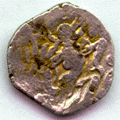
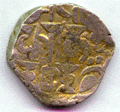
Bhoja I or Mihira Bhoja
836-885 AD
Imperial Pratihara, silver drachm
Obverse: Aadivaraha, Anthropoid boar representing incarnation of Vishnu standing with leg raised.
Reverse: A legend in Brahmi `Sri Mada Varaha; a fire altar flanked by two stylized attendants.
Weight: 3.9 gm
Reference: MNW#336-348
The specimen on right is from British Museum

The Hindu Shahi of Kabul
During 717 to 920 AD the Kabul valley, Zabul and Gandhara, till river Sindhu or Indus, (modern Afghanistan and Pakistan) was occupied by Turko-Hephthalic kings. Because of spread of Hinduism in these kingdoms, these dynasties were popularly known as `Hindu Shahis of Kabul and Gandhara’. At this time Arabs united under banner of Islam and made many advances on Shah of Kabul and Ratbil of Zabul. Ratbils succumbed to muslims after brave struggle in 870 AD. Shah of Kabul, a proud descendant of Great Kushan emperor, Kanishka, maintained his kingdom till the end of ninth century and later replaced by Kallar or Lalliyas who founded Hindu Shahiya dynasty of Udabhandapura (Ohind or WaiHind or Und, near modern Attock in Punjab, Pakistan).
This Brahmanical Shahi of Afganistan and Punjab (modern Pakistan) minted interesting coins, called `bull and horseman’ type coins which were later adopted by many post-Gupta dynasties; an example of Chahaman/Chauhan dynasty is shown below. Interestingly, these coins were also widely used as prototype by all muslim conquerors and rulers of North-west part of India which includes Mahmud of Ghor. These coins were first minted by Spalapati Deva in mid-ninth century. Later on the Samanta Deva coinage was used as prototype for increasingly debased coinage (an alloy of silver and copper known as Billon) struck by many dynasties. Shown below is a fine example of coin of this dynasty. On the obverse is a horseman who holds a long spear with legend “Bhi” on left margin.The reverse of these silver coins display a recumbent bull partly draped with an ornamental cloth and stamped with the mark of trident on his rear flank. Above is the legend, “Shri Samanta Deva“.
Shown on right is an amazing sculpture of Lord Vishnu made during Shahi of Kabul rule, found in Punjab, and currently housed in Metropolitan Museum of Art.
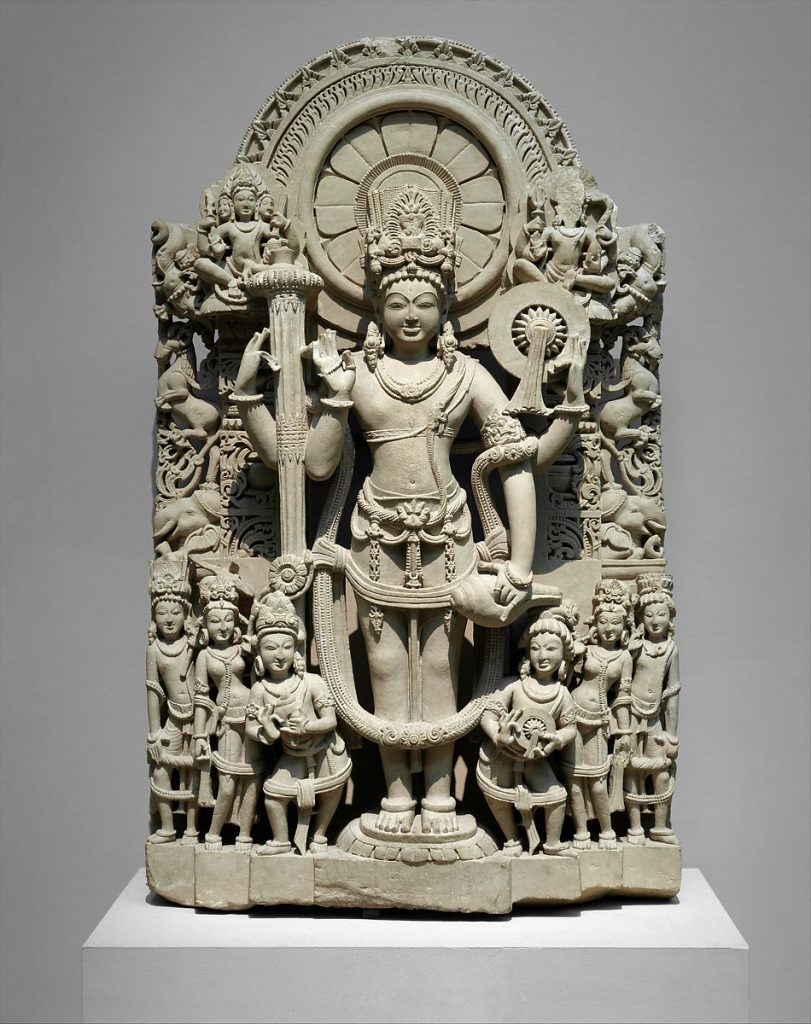
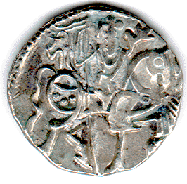
Samanta Deva
Hindu Shahi of Kabul, 850-1000 AD
Silver jital
Obverse: Horseman with spear in his hand, a Devanagri letter `Bhi’ on left
Reverse: Bull sitting to Left. Nagari Legend Above, “Sri Samanta Deva“; Ohind (Udabhandapura) Mint
Weight: 3.3 gm
Reference: MNW#1585, T14, D45

Samanta Deva
Hindu Shahi of Kabul, 850-1000 AD
Silver jital
Obverse: Horseman with spear in his hand, a Devanagri letter `Bhi’ on left
Reverse: Bull sitting to Left. Nagari Legend Above, “Sri Samanta Deva“; Ohind (Udabhandapura) Mint
Weight: 3.3 gm
Reference: Tye 14
CNG Auction, 405, Lot#271
COINS OF North-Central DYNASTIES
By tenth century the Kshatriyas or warriors of northern India, who were descendants of post-Gupta rulers, depending upon their lineage, divided into various clans and carved out kingdoms in north-central India. Much later these clans collectively took up a name for themselves, Rajputs, sons of Kings (derived from Sanskrit word Rajputra). It is to be noted that `Rajput’ identity was not widely accepted till 13th century. These warrior clans often fought among themselves to assert the supremacy, but none could built an empire of the Gupta or Kushan rulers. Instead, the northern, central and western parts of India was divided among many of these rulers into kingdoms of various sizes. This was the major factor which prompted the Islamic invaders to pour in India, mainly from Afghanistan and central Asia, as there was no central authority present to challenge them.
Most of these rulers minted coins of very similar fabric. Their gold coins were almost always had stylized Laxmi on obverse, the design of which was essentially derived from Gangeyadeva coinage (originally from Gupta coins), while reverse had name of the ruler in Devnagri script. The weight of these gold coins was maintained to be four and half Masha, which is equivalent to about 3.6 gms. The silver coinage was almost entirely copied from Bull-Horseman type coin of Hindu Shahi of Kabul (an example of which is shown above), except the name of ruler was changed. Unfortunately, no ruler (Vigraharaja may be an exception, who created his own distinct icon, shown below) made any serious attempt to introduce new motifs or design on their coinage, nor any monetary reforms were introduced. The debasement of coinage was widespread and artistry was perhaps lowest in entire history of India.
The Kalachuris of Tripuri or Dahal
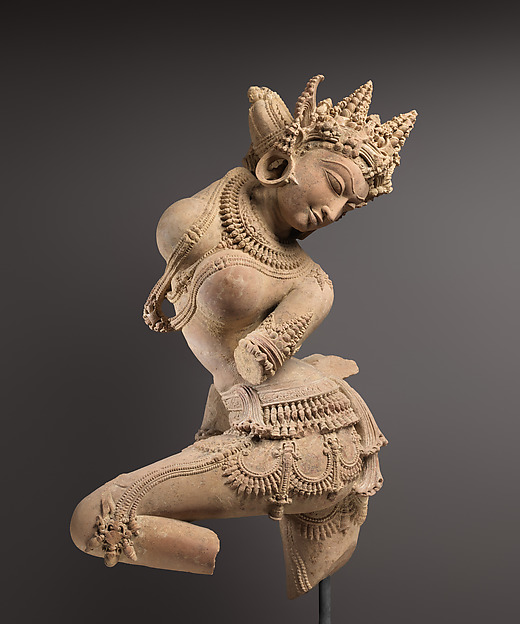
Disintegration of Pratihara empire signaled emergence of multiple new dynasties. The feudatories of old empires took up a difficult task of defending India against new foreign invaders, Turks. In tradition of great Vikramaditya (Chandragupta II) who killed Shaka ruler, a foreigner in his own city, these new kings too took titles `Vikramaditya or new Shahasankas. One notable king was Gangeyadeva of Kalachuris who did considerable justice to his title of Vikramaditya. He brought large part of Gangetic plain under his command and cemented friendships with strong neighbors by matrimonial alliance, thus bringing the glorious traditions of Harsha and Bhoja days. He had his capital at Tewar or Dahala, which is located near modern city of Jabalpur in Madhya Pradesh. On his death, his son Lakshmi Karna became the next ruler who too exhibited fine qualities. But after him the power was passed on to next major dynasty of northern India, Gahadvala.
After decline of Gupta dynasty, gold coins simply disappeared from India. Indeed very few dynasties minted silver coins of high purity. Almost the entire monetary system of northern India (a similar trend is noticeable in south too) was based on billon (a alloy of silver and copper) coins, either derived from Hindu Shahi of Kabul and Indo-Sassanian type silver coins based on Bhoja’s Aadivaraha type coins (shown above). It was Gangeyadeva who brought the gold coinage in vogue in Central/Northern India, which became so popular again (the reason was obvious, they were copies of Gupta!) that many other dynasties followed the suit. Shown below is coin of Gangeyadeva, which depict goddess of wealth, Laxmi seated on lotus. Although it is highly stylized version of Laxmi or Lakshmi shown on Gupta gold coins, the well proportional limbs, narrow waist, deep naval, well developed breasts and graceful appearance still remind that Gupta influence was not lost even almost 500 years after their decline.
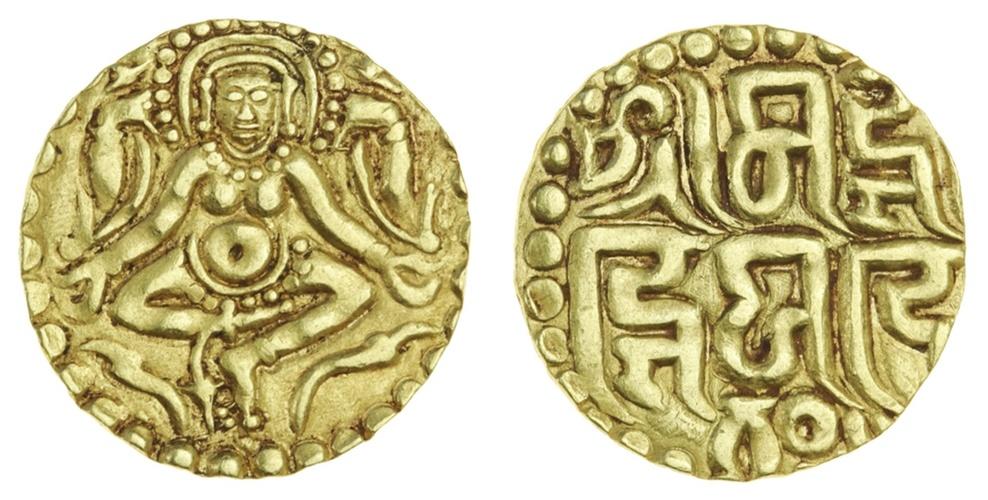
Gangeyadeva
Kalachuris of Tripuri 1019-1042
gold Unit of 4½-Masha, 4.17g,
Obverse: Lakshmi seated facing
Reverse: legend `Srimad gangeya devah‘
Reference: MNI. 411; Deyel 119
Spink Auction, London, Lot#928, Jan 2019
The Kacchapaghata (Kacchwahas) of Narwar
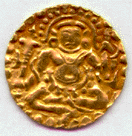
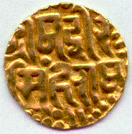
Vira Simha Ram
1120-1121 AD
Kingdom of Narwar Gold Stater
Obverse: Laxmi holding various objects, sitting
Reverse: Name of king in Devnagri Shrimad Vira Simha Ram
Weight: 4.4 gm
Reference: Deyell#153
Extremely Rare
Narwar is located in northern part of modern Madhya Pradesh state in central India. This kingdom has roots in mythology. It was the capital of legendary king, Raja Nala, who find his name in the great Sanskrit epic, Mahabharata (the story of Nala and his queen Damayanti is told even today). This town was called Nalapura (named after King Nala) until the 12th century. In 10th century, this kingdom came to prominence when the Kacchapaghata (later Kacchawaha Rajput) rulers occupied the Narwar fort, which stands on a steep scarp of the Vindhya (mountains of central India) Range. From the 12th century onward, Narwar was held successively by Kacchwaha, Parihar and Tomar Rajputs until its capture by the Mughals in the 16th century. It fell to the Maratha chief Mahadaji Shinde (Sindhia) in the early 19th century and remained part of Shinde kingdom till independence.
Shown above is a extremely rare medieval coin showing Laxmi minted by Narwar rulers, which has complete legends, the name of the ruler ShriMaDaVi Ra SimHaRaMa, written in Devanagri script, preserved on reverse.
Gahadvala of Banaras and Kannauj
Gahadavala dynasty was established by Chandradeva, but it was during rule of Govindchandra, the grandson of Chandradeva, this dynasty reached it’s pinnacle of power. Govindchandra occupied most of the Gangetic valley consisting of modern Bihar and Uttar Pradesh states. He had his capital at Banaras and it was a prosperous kingdom. He fought gallantly and was able to save his capital multiple times from the Gazanavid raids
At this juncture a rival empire was established at the western boundary of Gahadavalas. This kingdom was by another clan, Chahmanas. The grandson of Govindchandra, Jaichandra (Jai Chand in popular folklore) was the last Gahadavala ruler. According to legends, Jaichandra’s daughter eloped with the King of Chahamana/Chauhan dynasty, Prithviraja III, which added bitterness to long standing rivalry. When Mahmud of Ghor (or Ghur) invaded India, Gahadvala and Chahmana, the two most prominent dynasties of northern India, could not put up a joint front against foreign invader. Ghori defeated both Prithviraja and Jainhandra separately.
Shown below is a coin of greatest ruler of this dynasty, Govindchandra. Like Kalachuris of Tripuri, even Gahadavalas minted gold coins showing highly stylized version of seated Laxmi or Lakshmi depicted on Gupta gold coins. The reverse of the coin has the name of the ruler `SriMada Govind Chandra Deva‘ written in Devanagri script. All the rulers of this dynasty minted coin in the name of Govindchandra.

Govindchandra
1114-1155 AD
Gahadvala of Banaras and Kannauj, Gold Stater
Obverse: Laxmi sittinh
Reverse: Legend in Devnagri, Shrimad Govind Chandra Deva
Weight: 4.3 gm
Spink Auction
The Chahamanas of Sambhor, Ajmer and Delhi
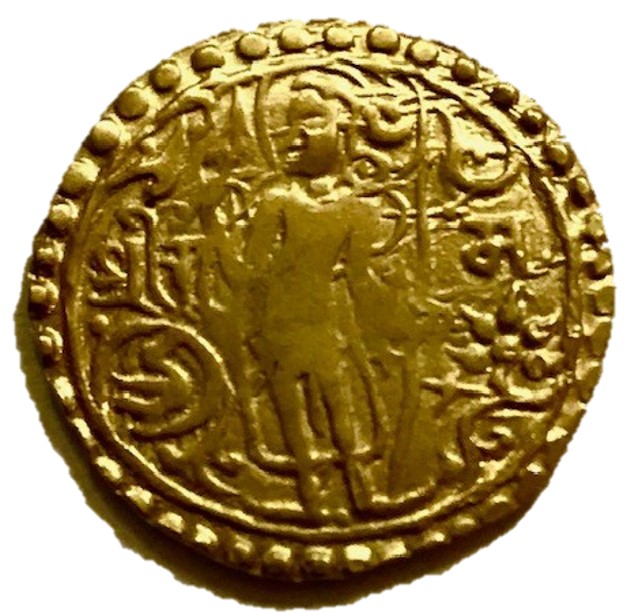
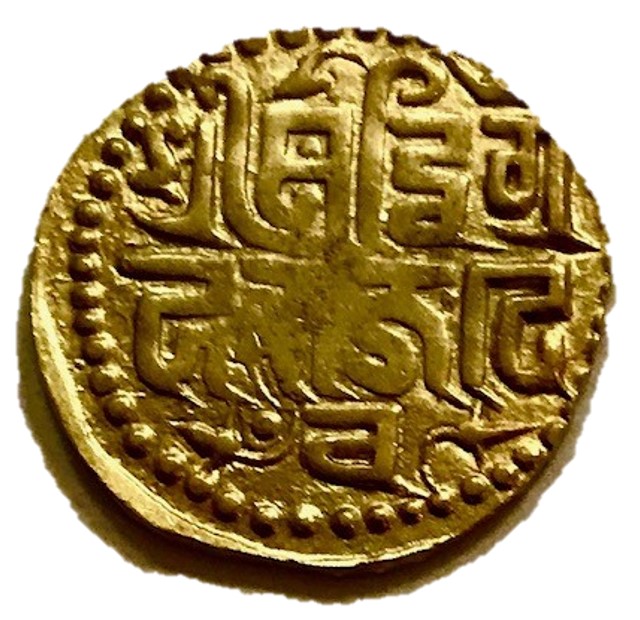
Vigraharaja IV
1153-1163 AD
Chahamans of Sambhor and AjmerGold Stater
Obverse: Lord Rama holding bow wandering in forest
Reverse: Legend in Devnagri, Shrimad Vigraha Raja Deva
Weight: 4.3 gm
Very Rare

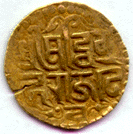
In the middle of 11th century AD Tomara chieftains founded a city on banks of Yamuna (Jamuna) river, Dilli or Delhi, named after goddess Dhillika), which was later taken over by Chahamans (Chauhans in later days). Vigraharaja IV was the greatest ruler of Chahamana dynasty who enlarged his dominion over large part of northern India, which included modern Punjab, Haryana, Delhi, Rajasthan and Uttar Pradesh. His capital was at Ajaymeru, modern Ajmer. Another major city of this kingdom was Sakhambari or Sambhor (the ancient name of this town is Stambhapura), which is located near Ajmer city in Rajasthan and thus dynasty came to known as Chahamans of Sambhor and Ajmer.
Vigraharaja, also known by his local name, Visala Deva or Bisal Deo, was a fine general and records of his many conquests of neighboring kingdoms have survived. It was Vigraharaja who took control of Delhi from Tomara ruler, according to the Bijolia rock inscription. In addition, he was also a great patron of art, architecture and literature. He build Bisaldeo temple, dedicated to Gokarneshwar (Lord Shiva), located near Tonk in Rajasthan. This is a classic example of medieval temple building (shown below).
Vigraharaja minted very interesting coins. Shown above are gold coins of this great king, which are very special. Unlike the trend in that period wherein coins had goddess Laxmi or Lakshami, the obverse of his coin show Lord Rama, hero of epic Ramayana, wandering in the forest. According to the legend, Lord Rama was sent to forest for 14 years, and this very scene is depicted in this coin. Lord Rama holding bow in his left hand and is surrounded by trees and other animals. A bird like creature (possibly a peacock) is shown in left hand lower corner. The obverse also show the legend Shri Ra Ma written in Devanagri script, in vertical format, reminiscent of Kushan gold coins (the trend was continued with Later Kushans and Gupta gold coins too). The reverse shows the name of the King, Srimada Vigra/haraja De/va in Devanagri script. This is a very interesting coin and represent ONLY numismatic representation of this popular deity of Hinduism. This unique coin is also quite rare.
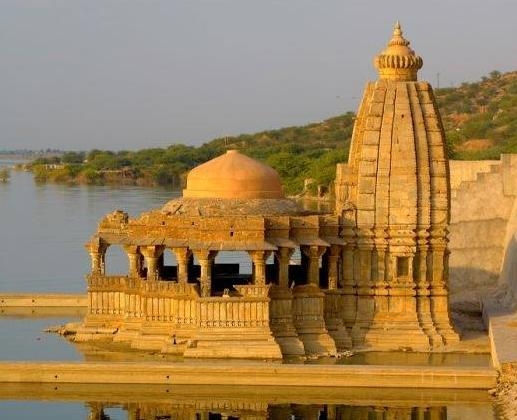
Vigraharja’s illustrious grandnephew, Prithviraja III (also known as Rai Pithora in literature) came into conflict with grandson of Govindchandra, Jayachandra (Jaichand). The rivalry between these two most powerful dynasties of northern India weakened both the kingdoms. And this opportunity was cleverly exploited by Muhammad Ghori (bin Sam). Ghori was raiding northern India fairly regularly, primary purpose of these annual raids was to maximize the loot. The temples were obvious targets, many were fabulously wealthy and were rarely guarded. His raids of temples and subsequent desecration of idols (Somnath temple raid in particular) is well documented in contemporary writing. It was inevitable that Mahmud and Prithviraha would come face-to-face and in first such battle, Prithviraja defeated Ghori. There was possibility that Ghori could even have been caught, but unfortunately chivalrous Raja let that opportunity go. Ghori was back next year; overconfident Raja did not take this invasion seriously. Ghori was much better prepared and defeated Prithviraja, what is known as the `Second battle of Tarain’ (near Delhi). Prithviraja was captured alive, but soon Ghori blinded him and had him executed. Soon Ghori invaded and captured the city of Banaras, capital of Gahadavalas.
Prithviraja’s death marked new era in the Indian history. Shown below is popular coin of this gallant warrior, who is also the hero of epic poem Prithviraj Raso. The coin is made in the style of Hindu Shahi of Kabul (shown above), wherein obverse shows the Horseman (highly stylized here), with Devanagari legend (Sri) Prithviraja Deva around. The reverse show a Bull seated with Devanagari legend Asavari Sri Samanta Deva around.
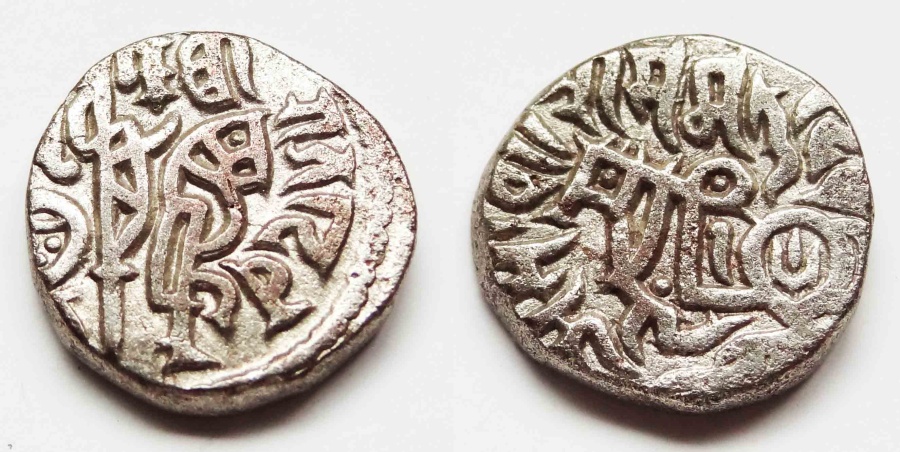
Prithvi Raja III
1163-1192 AD
Chahamans of Sambhor and Ajmer
Obverse: Horseman right, with Devanagari legend Sri Pri/thviraja Deva around
Reverse: Bull seated left, with Devanagari legend Asavari Sri Samanta Deva around
Billon Jital, Weight: 3.3 gm; Ref: Deyell 225
Vcoins, CT-001
Rulers of Chahamana dyansty were very fine warriors; both Vigraharaja and Prithviraja were reputed to be exceptional in their archery skills, the possible reason for Vigraharaja to show Lord Rama on his coins, also described to be the greatest archer in Ramayana. Vigraharaja in particular was prolific builder, he is known to have built a Sanskrit college and a temple dedicated to goddess Saraswati. This was located close to cluster of over 20 different Hindu and Jain temples at his capital, Ajmer. After the defeat of his descendant, Prithviraja, Ghori ordered his general Qutub-ud-din Aibak (later Sultan of Delhi), College/Sraswati temple to be converted into the Mosque. The nearby other temples were pulled down and used as a building material for this majestic and one of the earliest Islamic structure, a mosque, in India, today popularly known as Adhai din ka Zhopra. This imposing structure was later completed by Iltutimish, shown on right. It is well preserved and draws parallel to the Qutub Minar and other structures build in Delhi, post-conquest.
A stone tablet with Sanskrit play Lalita-Vigraharaja Nataka inscribed on it (and reference to Sanskrit college) was unearthed here. The play was composed by poet Somadeva, in honor of Vigraharaja and depicts the story of his love for princess Desaldevi, and his war preparations against a Turushka (Turkik) king, Hammir.
Loss of Delhi and Ajmer by Chahamana ruler had far reaching consequences in India history. Successive Islamic dynasties ruled central, northern and north-western India (modern Pakistan) for next 7 centuries, till Marathas overcame them to become next power broker of Indian subcontinent.
